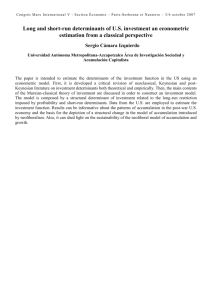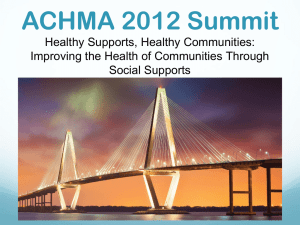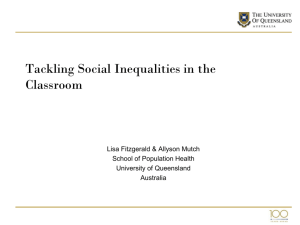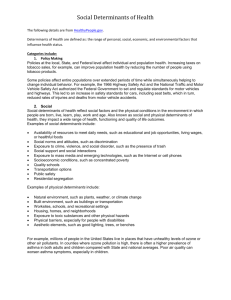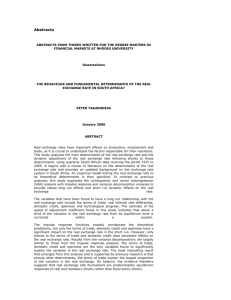ACTION ON THE SOCIAL DETERMINANTS OF HEALTH:
advertisement
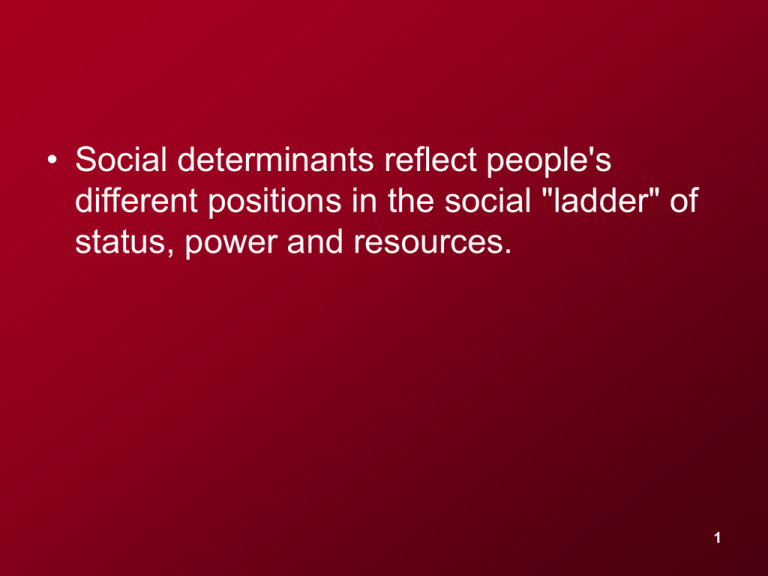
• Social determinants reflect people's different positions in the social "ladder" of status, power and resources. 1 Upstream/downstream: a story • The coming together of different sectors for the benefit of health, referred to as intersectoral action, is recognized as a key strategy to influence the social determinants of health. 3 Roots of a social approach to health • The recognition that social and environmental factors decisively influence people's health is ancient. • McKeown's analyses revealed that most of the substantial modern reduction in mortality from infectious diseases such as tuberculosis took place prior to the development of effective medical therapies. Instead, the main driving forces behind mortality reduction were changes in food supplies and living conditions. 4 The 1950s: emphasis on technology and disease-specific campaigns • 1. The series of major drug research breakthroughs that produced an array of new antibiotics, vaccines and other medicines in this period, inspiring health professionals and the general public with the sense that technology held the answer to the world's health problems. • 2. Many former colonies gained independence in the 1950s and 60s and established their own national health systems. On paper, post-independence health strategies often acknowledged the need to extend services to rural and disadvantaged populations, but in practice the bulk of government and international donor funding for health continued to flow to urban-based curative care. 7 The 1950s: (Remains) • International public health during this period was characterized by the proliferation of "vertical" programs narrowly focused, technology-driven campaigns targeting specific diseases such as malaria, smallpox, TB and yaws. • The vertical campaigns begun in this period generated a few notable successes, most famously the eradication of smallpox. 8 The 1960s and early 70s: the rise of community-based approaches • By the mid-1960s, it was clear in many parts of the world that the dominant medical and public health models were not meeting the most urgent needs of poor and disadvantaged populations (the majority of people in developing countries). 9 1970s • The importance of high-end medical technology was downplayed, and reliance on highly trained medical professionals was minimized. Instead, it was thought that locally recruited community health workers could, with limited training, assist their neighbors in confronting the majority of common health problems. Health education and disease prevention were at the heart of these strategies. 10 1970s • China's rural health workers (figuratively referred to as "barefoot doctors") were the most famous example. These were "a diverse array of village health workers who lived in the communities they served, stressed rural rather than urban health care, preventive rather than curative services, and combined western and traditional medicines. 11 1970s • By the early 1970s, awareness was growing that technologically driven approaches to health care had failed to significantly improve population health in many developing countries, while results were being obtained in some very poor settings through community-based programs. 12 The crystallization of a movement: Alma-Ata and primary health care • This new agenda took center stage at the International Conference on Primary Health Care, sponsored by WHO and UNICEF at AlmaAta, Kazakhstan, in September 1978. 3,000 delegates from 134 governments and 67 international organizations participated in the Alma-Ata conference, destined to become a milestone in modern public health. The conference declaration embraced Mahler's goal of “Health for All by the Year 2000”, with primary health care (PHC) as the means. 13 1980s • From the mid-1980s, SDH were also given prominence in the emerging health promotion movement. The First International Conference on Health Promotion -cosponsored by the Canadian Public Health Association, was held in Ottawa in 1986. The conference identified eight key determinants of health: peace, shelter, education, food, income, a stable eco-system, sustainable resources, social justice, and equity. 14 In the wake of Alma-Ata: "Good health at low cost" • "Good health at low cost" (GHLC) was the title of a conference sponsored by the Rockefeller Foundation in April-May 1985. The published proceedings became an important reference in debates about how to foster sustainable health improvements in the developing world. The conference closely examined the cases of three countries (China, Costa Rica and Sri Lanka) and one Indian state (Kerala) that had succeeded in obtaining unusually good health results (as measured by life expectancy and child mortality figures), despite low GDP and modest per capita health expenditures, relative to high-income countries. 15 How these countries used intersectoral policies addressing health determinants as key tools for improving population health indicators and in particular meeting the needs of vulnerable population groups. Costa Rica • Analysts of the country's success have underscored Costa Rica's strong policy link between health and education. Knowledge about health is regarded as an essential part of education at all levels, and the education system has consciously been used as a venue through which to promote good health. Due to the expansion of children's school during the 1940s and 1950s, the proportion of women who completed primary school increased from 17 percent in 1960 to 65 percent in 1980. This trend appears to have been a driver of the substantial decline in infant mortality during the 1970s. 17 Sri Lanka • Sri Lanka achieved strong improvements in health indicators following independence in 1948, despite the country's failure to generate sustained economic growth. An expansive primary health care system provided free to the entire population contributed significantly to population health gains. At the same time, proequity strategies across several social sectors played a major role in improving health outcomes. 18 Sri Lanka • Analysts found that this whole range of intersectoral actions was facilitated by the country's political system and culture of civil society participation. 19 selective primary health care • Selective PHC focused particularly on maternal health and child health, seen as areas where a few simple interventions could dramatically reduce illness and premature death. 20 selective primary health care • For critics of selective PHC, including recently Magnussen et al.: "the selective approach ignores the broader context of development and the values that are imbued in the equitable development of countries. It does not address health as more than the absence of disease; as a state of well-being, including dignity; and as embodying the ability to be a functioning member of society. In conjunction with the lack of a development context, the selective model does not acknowledge the role of social equity and social justice for the recipients of technologically driven medical interventions". • Cueto summarizes that, for its critics, SPHC was a "narrowly technocentric" strategy that turned away from the underlying social determinants of health, ignored the development context and its political complexities, and resembled vertical programs. 21 SDH approaches at country level • Several countries made notable strides in the effort to address social dimensions of health through the 1990s and early 2000s. • The direct roots of contemporary efforts to identify and address socially-determined health inequalities reach back to the Canadian Report (1974) and the Black Report in the United Kingdom (1980). The Black study had little immediate policy impact in the UK, then governed by Prime Minister Margaret Thatcher's Conservative Party, whose leadership dismissed Black's recommendations. However, the document generated strong interest in portions of the scientific community. 22 categories of health determinants • The specific vocabulary of "social determinants of health" came into increasingly wide use beginning in the mid-1990s. • Tarlov (1996) was one of the first to employ the term systematically. Tarlov identified four categories of health determinants: genetic and biological factors; medical care; individual health-related behaviors; and the "social characteristics within which living takes place". 23 Conclusion • Today an unprecedented opportunity exists to tackle the roots of suffering and unnecessary death in the world's poor and vulnerable communities. The roots of most health inequalities and of the bulk of human suffering are social: the social determinants of health. 24 Conclusion • However, like other aspects of comprehensive PHC, action on determinants was weakened by the neoliberal economic and political consensus dominant in the 1980s and beyond, with its focus on privatization, deregulation, shrinking states and freeing markets. Under the prolonged dominance of variants of neoliberalism, state-led action to improve health by addressing underlying social inequities appeared unfeasible in many contexts. 25 Social Determinants of Health: The Solid Facts - social gradient - stress - early life - social exclusion - work - unemployment - social support - addictions - food - transport - World Health Organization, 1998 Ottawa Charter’s Prerequisites of Health • peace • shelter • education • food • income • a stable eco-system • sustainable resources • social justice • equity World Health Organization, 1986 • • • • • • • • • • • • Health Canada’s Determinants of Health Income and Social Status Social Support Networks Education Employment/Working Conditions Social Environments Physical Environments Personal Health Practices and Coping Skills Healthy Child Development Biology and Genetic Endowment Health Services Gender Culture Why Emphasize Social Determinants? • Social determinants of health have a direct impact on health • Social determinants predict the greatest proportion of health status variance • Social determinants of health structure health behaviours • Social determinants of health interact with each other to produce health Poverty and Health: Mechanisms Poverty can affect health in a number of ways: • income provides the prerequisites for health, such as shelter, food, warmth, and the ability to participate in society; • living in poverty can cause stress and anxiety which can damage people’s health; • low income limits peoples’ choices and militates against desirable changes in behaviour. - Benzeval, Judge, & Whitehead, 1995, p.xxi, Tackling Inequalities in Health: An Agenda for Action. Defining Poverty Individuals, families and groups in the population can be said to be in poverty when they lack the resources to obtain the type of diet, participate in the activities and have the living conditions and amenities which are customary, or at least widely encouraged, or approved, in the societies to which they belong. They are, in effect, excluded from ordinary living patterns, customs and activities -- Townsend, 1979, p.31 It was found that those living in lower income areas were much more likely to develop coronary heart disease than those in well-off neighbourhoods. These effects remained strong even after controlling for tobacco use, level of physical activity, presence of hypertension or diabetes, level of cholesterol, and body mass index. - Summary of Neighbourhood of Residence and Incidence of Coronary Heart Disease, A. Roux, S. Merkin, D. Arnett, et al. New England Journal of Medicine, 2001, 345, 99-106. Ten Tips For Better Health - Donaldson, 1999 1. Don't smoke. If you can, stop. If you can't, cut down. 2. Follow a balanced diet with plenty of fruit and vegetables. 3. Keep physically active. 4. Manage stress by, for example, talking things through and making time to relax. 5. If you drink alcohol, do so in moderation. 6. Cover up in the sun, and protect children from sunburn. 7. Practise safer sex. 8. Take up cancer screening opportunities. 9. Be safe on the roads: follow the Highway Code. 10. Learn the First Aid ABC : airways, breathing, circulation. Ten Tips for Staying Healthy - Dave Gordon, 1999. 1. Don't be poor. If you can, stop. If you can't, try not to be poor for long. 2. Don't have poor parents. 3. Own a car. 4. Don't work in a stressful, low paid manual job. 5. Don't live in damp, low quality housing. 6. Be able to afford to go on a foreign holiday and sunbathe. 7. Practice not losing your job and don't become unemployed. 8. Take up all benefits you are entitled to, if you are unemployed, retired or sick or disabled. 9. Don't live next to a busy major road or near a polluting factory. 10. Learn how to fill in the complex housing benefit/ asylum application forms before you become homeless and destitute. Poverty and Health: Literary Perspectives We know what makes us ill. When we are ill we are told That it’s you who will heal us. When we come to you Our rags are torn off us And you listen all over our naked body. As to the cause of our illness One glance at our rags would Tell you more. It is the same cause that wears out Our bodies and our clothes. -- Bertolt Brecht, A Worker’s Speech to a Doctor, 1938.

